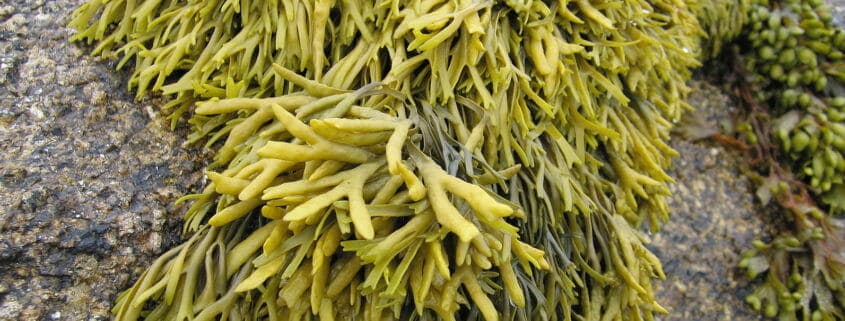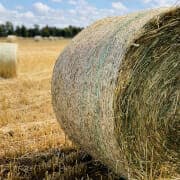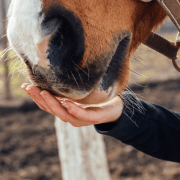Seaweed for Horses: Miracle Supplement or Massive Con?
There has been much debate about the potential benefits to be gained from feeding seaweed to horses. On one side, we have seaweed being reported as a multifunctional supplement that will act as an anthelmintic, antacid, immuno-stimulator, anti-inflammatory, anti-cancer, anti-bacterial, anti-ulcer, heavy metal scavenger, fertility enhancer, nerve calmer, thyroid stimulator and skin and coat conditioner. From the other side, seaweed is called nothing more than a con, containing potentially dangerous levels of iodine and precious little of anything else. So who is right, and is there any middle ground to be sought in this argument?
What is seaweed?
Seaweed is a marine plant that can be found in oceans all around the world. There are approximately 1700 different varieties of seaweed and they come in three different colours; green, brown and red. The green seaweeds generally grow close to the water’s surface and are smaller than the brown and red varieties. Brown seaweed grows in slightly deeper and often cold waters, while the red seaweeds grow in very deep waters. It is the brown seaweed (also called Kelp) that is commonly fed to horses in Australia.
Why seaweed for horses?
Generally people will add seaweed to their horse’s feed to supply trace minerals that are lacking in the pasture, hay and concentrates being fed to the horse. Effectively, seaweed is used as a trace mineral supplement.
Is seaweed a good trace mineral supplement?
Seaweed supporters will readily tell you that seaweed contains ‘every nutrient needed by the horse’ including 48 minerals, 16 amino acids and 11 vitamins, making it sound like a very attractive and natural option for trace mineral supplementation. However, the concentration of minerals in seaweed is so low that when fed at the levels generally recommended for horses (15 to 30 grams/day) it makes virtually no contribution to satisfying a horse’s trace mineral requirements, with the exception of iodine (Table 1).
Table 1: The percent of daily nutrient requirements for a 500 kg horse in light work satisfied by 20 grams of seaweed containing 600 mg/kg of iodine or by 20 grams of a well formulated commercial trace mineral supplement.
| Trace Mineral |
% of daily requirement satisfied by 20 g of Seaweed |
% of daily requirement satisfied by 20 g of a commercial trace mineral supplement |
|---|---|---|
| Copper | 0.01 | 62 |
| Zinc | 0.06 | 44 |
| Selenium | 0.1 | 52 |
| Manganese | 0.05 | 44 |
| Iodine | 706 | 68 |
| Iron | 1.96 | 35 |
When it comes down to it, seaweed gives your horse very little benefit from a trace mineral perspective (with the exception of iodine, which is grossly oversupplied), particularly when considered in comparison with a well formulated commercial supplement.
How much iodine does seaweed contain?
The iodine concentration of seaweed is generally highly variable and depends on many factors including the variety of seaweed and the age of the blades that were harvested and analysed. In a study conducted in 2004 (Teas et al.) researchers found that the concentration of iodine in 12 different seaweeds varied from 16 mg/kg to 8165 mg/kg. They also found that within the same variety of seaweed, iodine concentration ranged from 514 mg/kg of iodine in the older sun‐bleached blades to 6571 mg/kg in the juvenile, fresh blades, demonstrating the highly variable concentrations of iodine that may be present in a seaweed product.
How much iodine do horses need?
Horses require between 0.35 and 0.4 mg of iodine/kg of dry matter consumed per day. Thus a 500 kg horse consuming 2% of its body weight in feed per day will need between 3.5 and 4 mg of iodine per day. Iodine toxicity will occur at intakes of 5 mg/kg of dry matter consumed per day, which is equal to approximately 50 mg/day for a 500 kg horse.
Can seaweed cause iodine toxicity?
YES! Iodine toxicities can definitely occur when horses are fed too much seaweed. So, how much seaweed is too much? Well, that all depends on the concentration of iodine in the seaweed. Eighty grams of seaweed that contains 600 mg/kg of iodine will need to be fed to cause acute iodine toxicity in a 500 kg horse, while just 6 grams of seaweed containing 8000 mg of iodine/kg will cause acute toxicity in the same horse.
Chronic toxicity may also be a problem in horses. The effects of feeding relatively high concentrations of iodine to a horse over a long period of time (for example you may feed 20 grams per day of a 600 mg/kg iodine seaweed for 6 months, providing your horse that has a requirement of 2 mg of iodine/day with 12 mg of iodine per day) have never been studied in horses. Studies in humans however (Pearce et al. 2002; Mizukami et al. 1993) have shown that iodine toxicity can be precipitated through long term exposure to moderately high concentrations of dietary iodine. Thus the answer to the question ‘how much is too much?’ is ‘we don’t know’, meaning seaweed must be fed with extreme caution, if it is to be fed at all.
Is there any time that seaweed is useful in a horse’s diet?
Given the high iodine concentration in seaweed, it can be useful to feed as an iodine supplement when there is a demonstrated iodine deficiency. Remember that an iodine deficiency will cause virtually exactly the same symptoms as an iodine toxicity (goitre, a dry, lustreless coat, lethargy, dullness, drowsiness and timidity, inappetence and cold intolerance). Thus the only way to diagnose and differentiate an iodine deficiency from toxicity is to carefully analyse the iodine content of the feeds your horse is eating. If an iodine deficiency is diagnosed and you decide to feed seaweed, carefully calculate the amount required by your horse using the iodine concentration specified on the particular product you are using. Do not overfeed seaweed in an attempt to rapidly correct your horse’s iodine deficiency as you will end up correcting the deficiency only to cause a damaging toxicity.
4 things you must do before you feed seaweed to your horse
- Consider exactly why you want to feed seaweed. If you can’t pinpoint a good reason such as a demonstrated iodine deficiency, then it is probably best you don’t feed seaweed at all.
- Obtain the iodine content of the seaweed product you wish to use. If the product you are considering does not specify its iodine content do not feed it. Never feed your horse anything unless you know what is in it. If you have your seaweed tested for iodine concentration, send us the analysis at FeedXL and we can put your specific analysis with the tested iodine level into your personal FeedXL database.
- Using the products specified iodine concentration, calculate how much you need to feed per day to satisfy but not substantially exceed your horse’s iodine requirements. When using FeedXL, this is easy. Simply put enough seaweed meal into your horse’s diet to meet the calculated iodine requirement. No pen and calculator required.
FeedXL will also make sure that if your horse is being fed other iodine-containing supplements these are taken into account. - Carefully weigh and feed the calculated amount of seaweed to your horse each day. Never give your horse free access to seaweed; this will just be an iodine toxicity waiting to happen.
A special note about seaweed for mares and foals
There is a particular risk in feeding seaweed to pregnant and lactating mares. Excess dietary iodine accumulates in the placenta and is excreted in milk. Thus foals born to mares consuming diets high in iodine will be at risk of developing iodine toxicity. Foals from these mares may be born dead, or very weak, with a poor suckle response. Those who live and continue to suckle from their dam will likely develop skeletal abnormalities as iodine toxicity causes low serum thyroxine hormone concentrations and the thyroxine hormone is crucial for cartilage maturation and bone formation.
The final slime…
Think carefully about feeding seaweed to your horse. If your horse doesn’t need additional iodine in its diet, then think carefully about the claimed benefits before you feed seaweed. If you do decide to feed it, do so with extreme caution, ensuring that you always use FeedXL to calculate the amount to feed and weigh and feed that amount accurately. Don’t guess, it’s definitely not good for your horse’s health!
Join FeedXL today and take control of your horse’s nutrition
Get EVEN MORE practical and personalised feeding guidance when you sign up to FEEDXL.
Do you have a question or comment? Do you need help with feeding?
We would love to welcome you to our FeedXL Horse Nutrition Facebook Group. Ask questions and have them answered by PhD and Masters qualified equine nutritionists and spend time with like-minded horse owners. It’s free!
Click here to join the FeedXL Horse Nutrition Facebook Group











